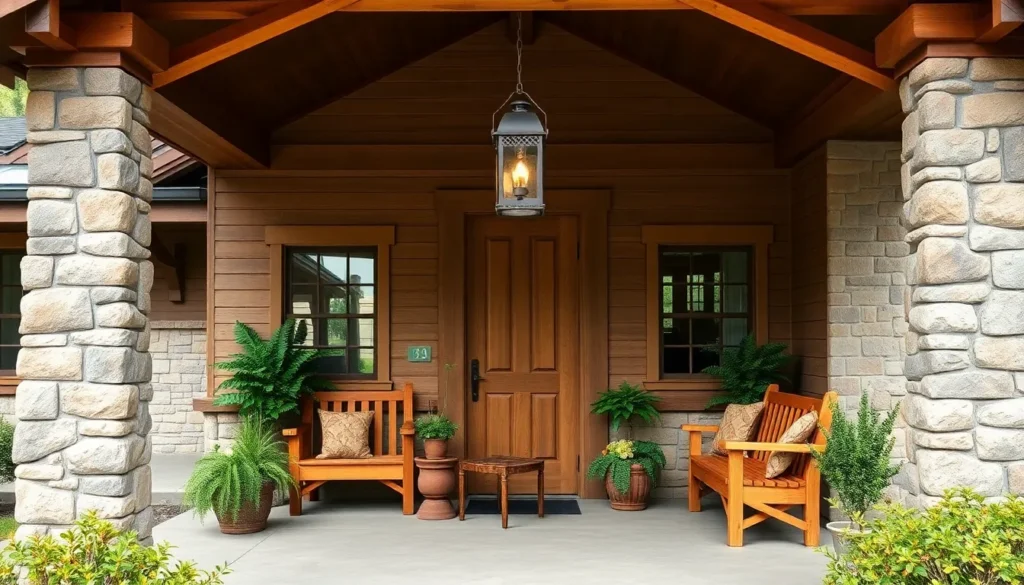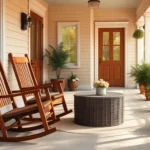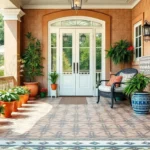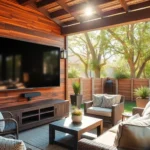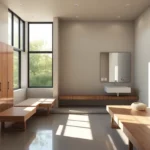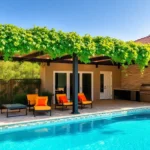We’ve all admired those stunning Craftsman homes with their inviting front porches that seem to whisper “come sit and stay awhile.” These architectural gems from the early 1900s continue to captivate homeowners with their perfect blend of functionality and timeless charm. Whether you’re renovating an existing Craftsman porch or adding these classic elements to your current home, the right design choices can transform your entrance into a welcoming retreat.
The beauty of Craftsman front porches lies in their attention to detail and emphasis on natural materials. From signature tapered columns and exposed beam ceilings to built-in seating and decorative brackets, every element serves both form and function. We’re excited to share proven ideas that’ll help you create an authentic Craftsman porch that not only boosts your home’s curb appeal but also provides the perfect space for relaxation and connection with your neighborhood.
Ready to discover how simple design elements can make a dramatic impact on your home’s exterior?
Classic Craftsman Columns and Pillars
Choosing the right columns and pillars transforms your front porch into an authentic Craftsman masterpiece. We’ll explore three timeless approaches that capture the architectural essence of this beloved style.
Tapered Stone Columns
Stone columns create the most dramatic and enduring foundation for Craftsman porches. These sturdy supports typically measure 18 to 24 inches wide at the base and taper to 12 to 16 inches at the top, creating visual interest while maintaining structural integrity.
River rock, fieldstone, and stacked limestone offer natural textures that complement the organic aesthetic of Craftsman design. We recommend using mortar joints that are slightly recessed to emphasize the individual stones and create authentic shadow lines.
Pairing stone columns with wooden capitals adds warmth and prevents the supports from appearing too industrial. Cedar, redwood, or fir caps provide the perfect transition between the heavy stone base and your porch roof structure.
Square Wooden Posts
Wooden posts deliver the clean, geometric lines that define classic Craftsman architecture. These supports typically range from 8×8 inches to 12×12 inches, depending on your porch span and load requirements.
Cedar and redwood resist weather naturally, making them ideal choices for exposed porch elements. Douglas fir offers exceptional strength and accepts stain beautifully, allowing you to match existing trim colors or create striking contrasts.
Simple chamfered edges or subtle decorative caps enhance wooden posts without overwhelming their straightforward appeal. We suggest avoiding overly ornate details that conflict with the Craftsman philosophy of honest materials and functional beauty.
Mixed Material Combinations
Combining stone bases with wooden upper sections creates the signature Craftsman look that balances durability with visual warmth. Stone pedestals typically extend 24 to 36 inches high, supporting wooden posts that continue to the roof line.
This approach offers practical advantages beyond aesthetics. Stone bases resist moisture damage and ground contact issues, while wooden upper sections remain easy to maintain and replace if needed.
Popular combinations include river rock pedestals with cedar posts, stacked stone bases supporting redwood columns, or concrete block foundations topped with Douglas fir timbers. Each pairing creates distinct character while honoring traditional Craftsman proportions and materials.
Traditional Craftsman Railings and Balustrades
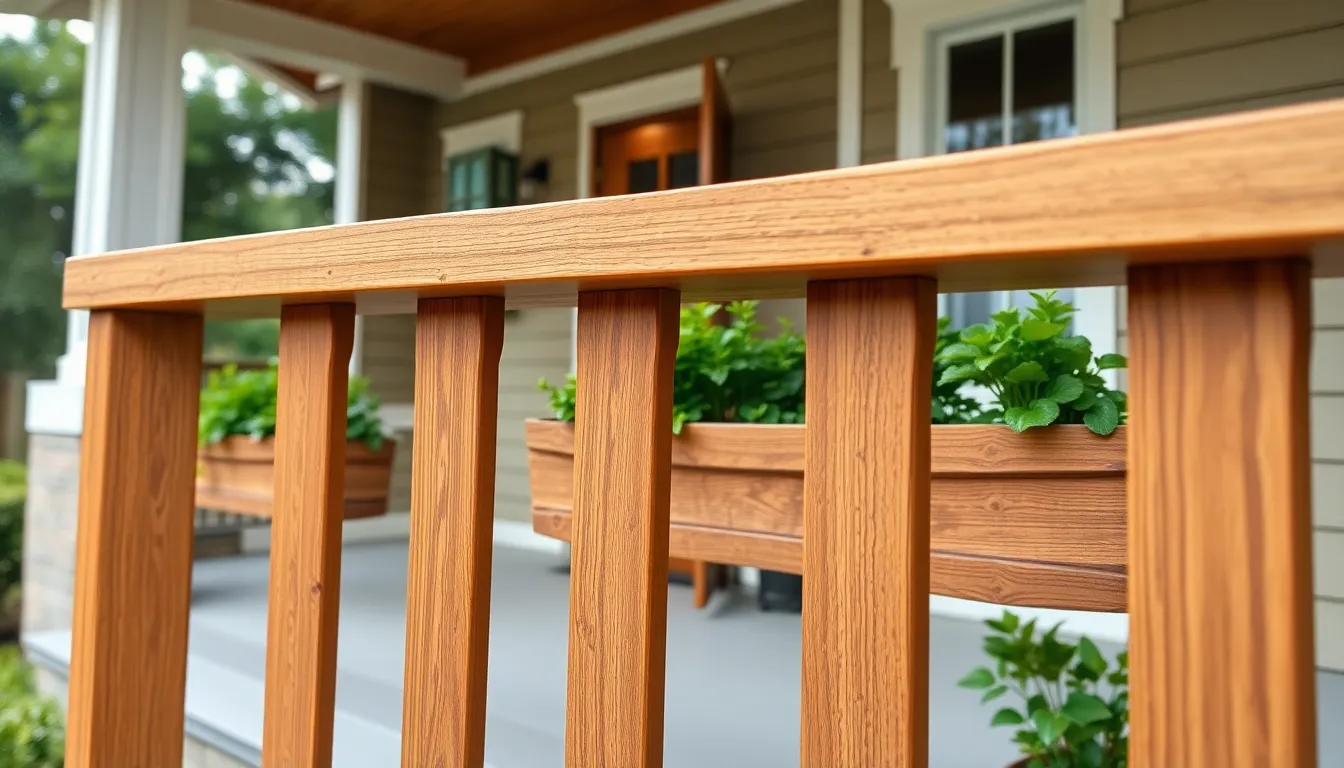
Building on your carefully selected columns and pillars, we’ll explore railing designs that complete the authentic Craftsman aesthetic. These railing styles emphasize the handcrafted quality and natural materials that define this timeless architectural approach.
Simple Horizontal Slat Designs
Horizontal slat railings offer a modern interpretation that stays true to Craftsman principles. We love how these designs use evenly spaced wood slats running horizontally rather than traditional vertical balusters. Natural stained wood creates the most authentic look, though painted finishes in earth tones work beautifully too.
Clean lines define this approach while maintaining the safety and enclosure your porch needs. Wood selection matters significantly here, with cedar and redwood providing natural weather resistance. These railings work particularly well when they match your column materials and colors.
Spacing between slats typically ranges from 4 to 6 inches for optimal visual balance. Installation requires precision to ensure each slat aligns perfectly with the next. Maintenance stays minimal when you choose quality materials and proper finishing techniques.
Geometric Pattern Railings
Geometric patterns showcase the Arts and Crafts movement’s attention to handcrafted artistry. We often incorporate rectangular cutouts, square designs, or diamond shapes within the balustrade framework. These patterns add visual interest without overwhelming the porch’s overall simplicity.
Rectangular frames with smaller geometric inserts create sophisticated focal points. Square cutouts arranged in repeating patterns offer clean, architectural appeal. Diamond lattices provide texture while maintaining the structured feel Craftsman style demands.
Construction typically uses wood painted in colors that complement your porch trim and columns. Precision cutting becomes essential for achieving the sharp, clean lines these patterns require. Professional installation often proves worthwhile given the detailed woodwork involved.
Built-In Planter Box Railings
Planter box railings connect your porch directly with nature, a core Craftsman principle. We integrate these planters into the top or bottom rail using matching wood or stone materials. This approach adds greenery while softening the hard lines of traditional railings.
Placement options include raised planters along the top rail or ground level boxes incorporated into the railing base. Cedar construction works exceptionally well for planters due to its natural rot resistance. Proper drainage becomes crucial, so we always include weep holes or drainage systems.
Plant selection should complement your home’s architectural style and local growing conditions. Native flowers and small shrubs typically work best for Craftsman porches. Regular maintenance keeps both the plants and wooden planters looking their finest throughout the seasons.
Authentic Craftsman Lighting Solutions
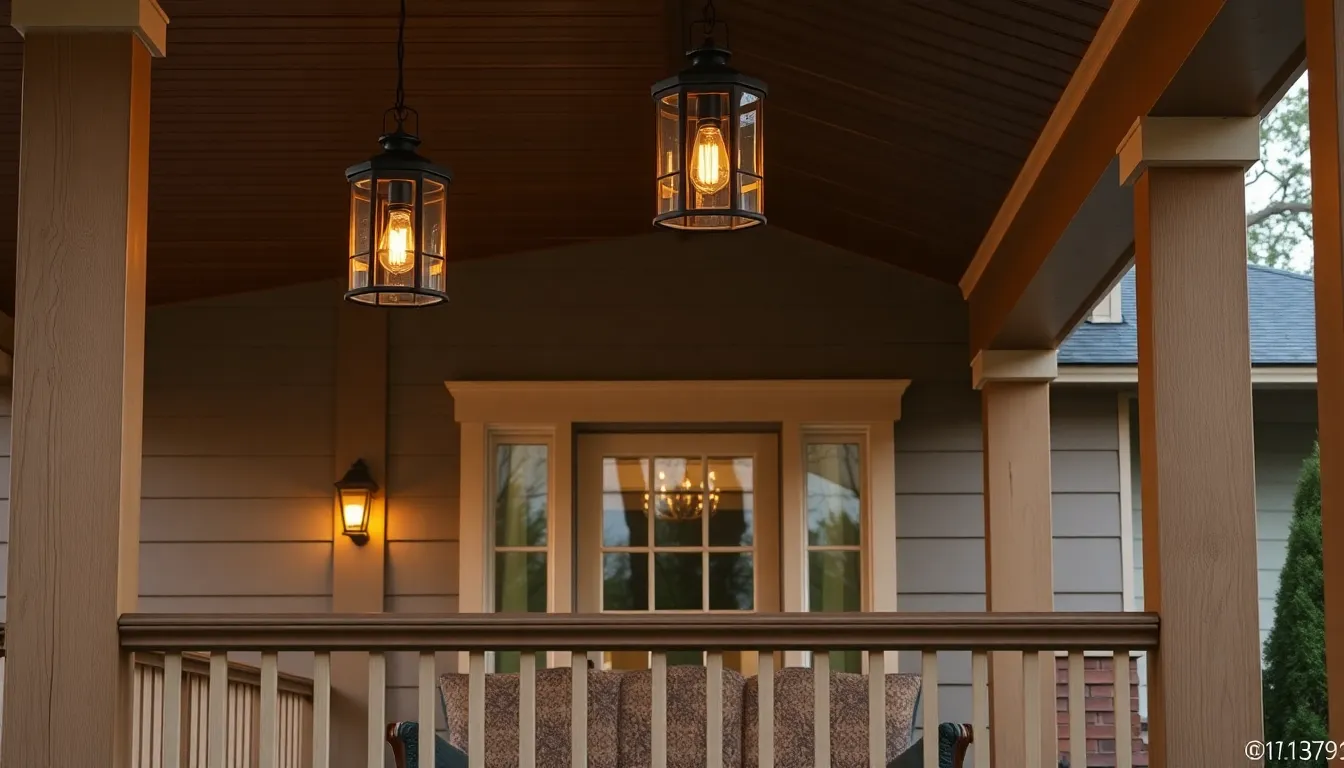
Now that we’ve established our porch’s structural foundation with columns and railings, we need to complete the authentic Craftsman atmosphere with period appropriate lighting that enhances both functionality and aesthetic appeal.
Lantern-Style Pendant Fixtures
Traditional lantern pendants create the perfect centerpiece for your Craftsman porch ceiling. We recommend hanging these fixtures directly over seating areas or entryways to provide focused illumination while maintaining the handcrafted aesthetic that defines Craftsman design. Choose pendants with warm bronze, copper, or black finishes that complement your porch’s natural materials.
Position lantern pendants to align with your porch’s architectural lines. Install them at least 7 feet above the floor to ensure adequate clearance while creating intimate lighting zones. Look for fixtures featuring clear or amber glass panels that allow warm light to filter through, creating the inviting glow that makes Craftsman porches so welcoming during evening hours.
Mission-Style Wall Sconces
Mission style wall sconces showcase the geometric patterns that define Arts and Crafts movement lighting design. Mount these fixtures on either side of your front door or along porch walls to create layered lighting that highlights architectural details like columns and railings. Select sconces with simple rectangular or square frames that echo the clean lines found throughout Craftsman architecture.
Install wall sconces at eye level, typically 66 to 72 inches from the floor. Choose fixtures with metal or wood finishes that match your porch’s existing hardware and trim. Look for sconces featuring frosted or stained glass panels that diffuse light evenly, creating the soft ambient lighting that transforms your porch into an outdoor living room.
Warm Edison Bulb Installations
Exposed filament Edison bulbs deliver the authentic vintage glow that perfectly complements Craftsman design principles. We recommend using these bulbs in both pendant fixtures and wall sconces to create consistent warm lighting throughout your porch space. Choose bulbs with 2200K to 2700K color temperatures to achieve the amber toned illumination that enhances natural wood and stone materials.
String Edison bulbs along porch eaves or between columns for additional ambient lighting. Install dimmer switches to control light intensity throughout different times of day, allowing you to create the perfect atmosphere for morning coffee or evening relaxation. Consider LED Edison style bulbs that provide the same vintage appearance while offering energy efficiency and longer lifespan than traditional incandescent options.
Natural Material Integration Ideas
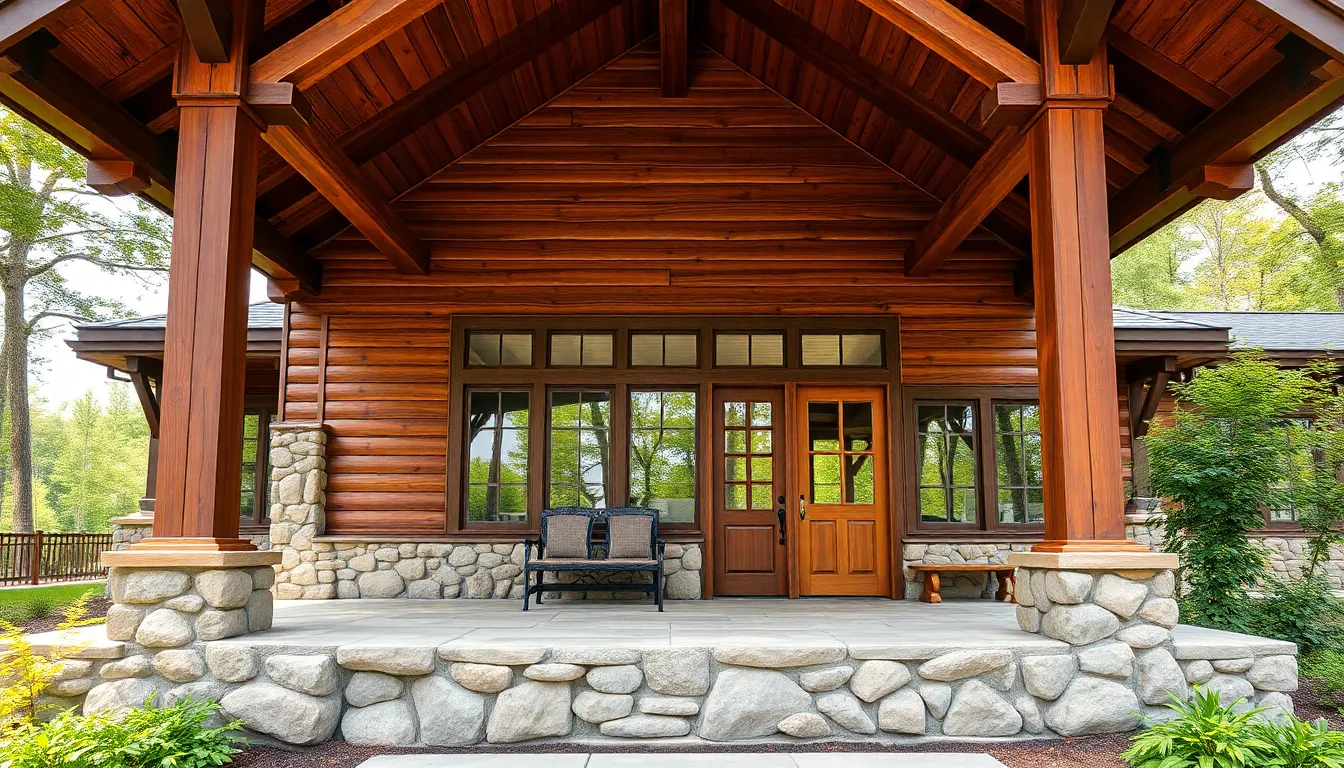
Building on our foundation of authentic columns and atmospheric lighting, we can elevate the Craftsman porch experience through thoughtful integration of natural materials that honor traditional craftsmanship.
River Rock Foundation Elements
River rock foundations create a stunning visual anchor for Craftsman porches while providing exceptional durability. These naturally rounded stones offer earthy tones and rustic textures that ground the porch design, creating a beautiful contrast against wooden architectural elements. Many homeowners choose to replace standard concrete foundations with river rock masonry for improved sturdiness and enhanced curb appeal.
We recommend using river rock for porch piers and skirting applications where the natural stone harmonizes perfectly with other Craftsman materials like wood and brick. The organic shapes and varied colors of river rocks highlight the handcrafted quality that defines authentic Craftsman design. Installing river rock elements requires careful attention to proper drainage and mortar selection to ensure long-term structural integrity.
Cedar and Redwood Accents
Cedar and redwood stand out as premium wood choices for Craftsman porch accents due to their exceptional durability and naturally beautiful grain patterns. These wood species resist decay and insect damage, making them ideal for exposed outdoor applications like columns, railings, and ceiling details. Their warm hues enhance the natural atmosphere of any Craftsman porch while accepting stains and finishes beautifully.
We find that cedar works particularly well for trim details and smaller accent pieces, while redwood excels in larger structural elements like beams and columns. Both materials align perfectly with traditional Craftsman principles of using honest, high-quality woodwork that ages gracefully over time. Proper sealing and maintenance help preserve the rich colors and protect these valuable wood investments from weather exposure.
Exposed Beam Ceiling Details
Exposed beam ceilings serve as signature architectural features that instantly communicate authentic Craftsman craftsmanship. These visible structural elements create a robust, handcrafted appearance that transforms an ordinary porch into an impressive outdoor living space. Heavy timber beams, whether left natural or carefully stained, add substantial visual weight and architectural interest to the ceiling plane.
We recommend incorporating tongue-and-groove wood planks between exposed joists to create a visually striking overhead structure that reinforces the natural artisanal atmosphere. Locally sourced wood like poplar or cedar adds unique character with natural color variations and authentic regional appeal. Some designs feature multi-colored wood such as rainbow poplar for extraordinary visual interest that celebrates the beauty of natural materials.
Proper beam sizing and spacing ensure both structural integrity and proportional balance within the overall porch design. The exposed ceiling elements work together with other natural materials to create a cohesive outdoor space that embodies the Craftsman commitment to quality construction and timeless aesthetic appeal.
Craftsman-Inspired Seating Arrangements
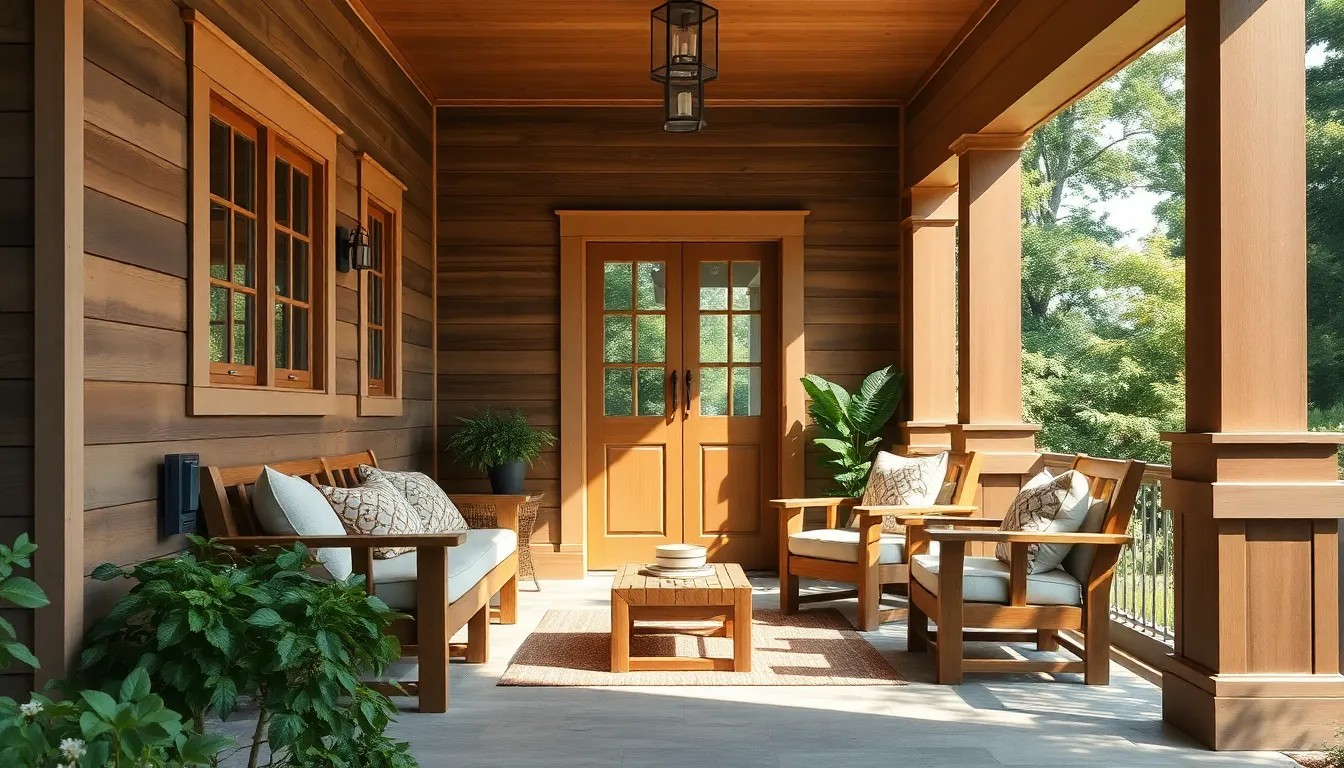
Now that we’ve established the perfect foundation with columns and natural materials, let’s create inviting seating areas that embody the Craftsman philosophy of comfortable functionality.
Built-In Wooden Benches
Built in wooden benches serve as integral architectural elements that seamlessly blend into your porch design. We recommend constructing these benches from natural wood that matches your porch columns and ceiling beams, creating a cohesive handcrafted appearance throughout the space.
Sturdy construction becomes essential when designing these permanent seating answers. We suggest using solid wood planks with mortise and tenon joinery to ensure durability while maintaining the authentic Arts and Crafts aesthetic. Position these benches along porch walls or beneath windows to maximize space efficiency.
Storage capabilities can enhance the functionality of your built in benches. We often incorporate hinged tops that reveal hidden compartments for cushions, outdoor games, or seasonal decorations. This dual purpose design reflects the Craftsman principle of combining beauty with practical utility.
Mission-Style Furniture Placement
Mission style furniture features the straight lines and flat panels that define authentic Craftsman design. We recommend selecting pieces with solid wood construction and minimal ornamentation to complement your porch’s architectural elements.
Grouping arrangements create welcoming social spaces that encourage conversation and relaxation. We suggest positioning a mission style wooden bench or rocker near your built in seating, then adding a rustic wood table as a central gathering point for books, beverages, or board games.
Balance becomes crucial when arranging multiple furniture pieces on your porch. We place larger items like benches against walls or railings, then add smaller chairs and side tables to create natural conversation areas without overwhelming the space.
Cozy Reading Nook Configurations
Reading nooks transform quiet porch corners into personal retreats for morning coffee or evening relaxation. We recommend starting with an upholstered mission style chair or wooden rocker positioned to take advantage of natural light throughout the day.
Side tables provide essential surfaces for books, beverages, and reading accessories. We suggest selecting pieces with lower shelves or drawers to keep magazines and novels within easy reach while maintaining the clean lines that define Craftsman style.
Shelter enhances comfort by protecting your reading space from weather elements. We often install pergolas or use deep porch overhangs to create shade while allowing filtered sunlight to illuminate your favorite reading spot during morning and afternoon hours.
Soft furnishings add comfort while respecting Craftsman color schemes. We choose cushions and throws in muted earth tones like sage green, warm brown, or deep burgundy to complement the natural wood and stone elements throughout your porch design.
Decorative Elements and Architectural Details
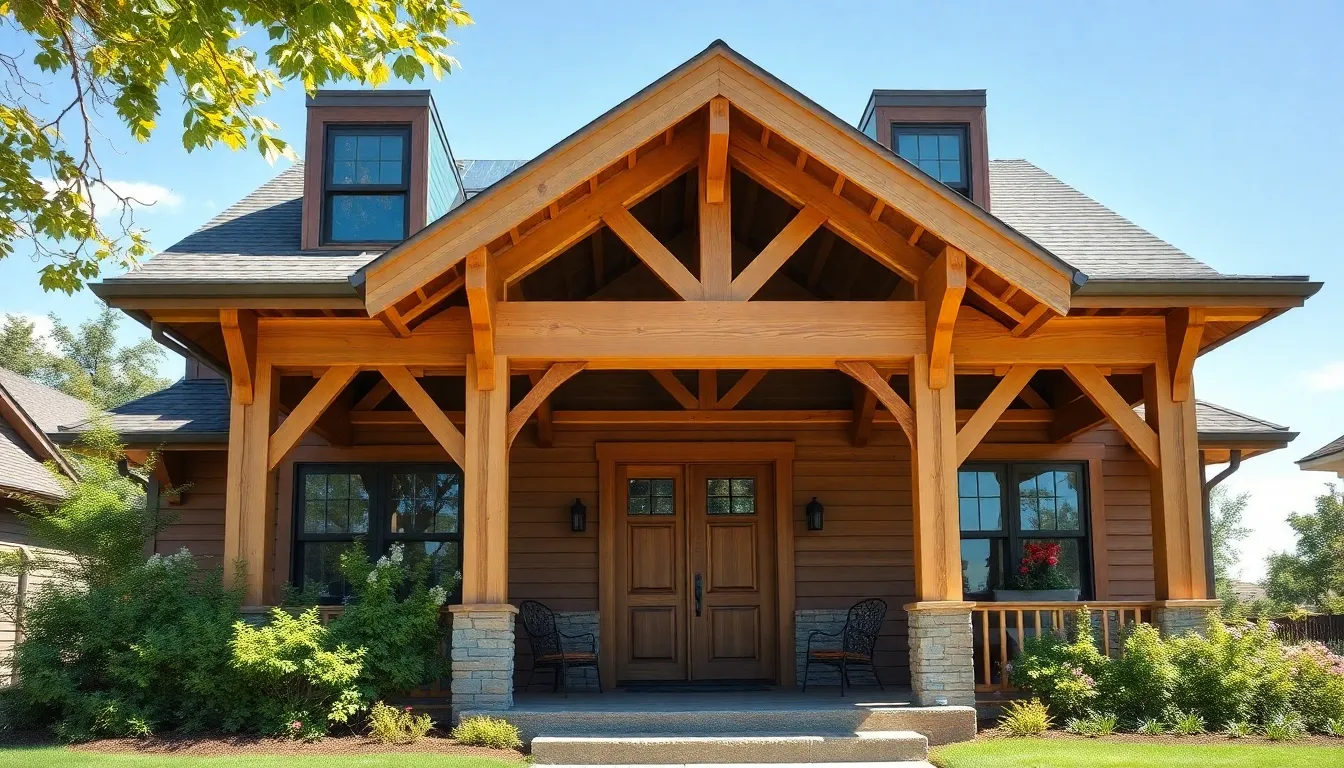
Building on the foundation we’ve established with columns, railings, and natural materials, we’ll now explore the distinctive architectural details that truly define authentic Craftsman porch design.
Exposed Rafter Tails
Exposed rafter tails beneath the porch eaves serve as one of the most recognizable hallmarks of Craftsman architecture. These visible rafter ends showcase the hand-crafted woodwork that defines the Arts and Crafts movement, creating rustic yet refined visual interest. We recommend leaving these structural elements completely exposed rather than boxing them in with trim boards.
Shaped rafter ends enhance the architectural character and authenticity of your porch design. Cutting curved or angled profiles into the tail ends adds decorative appeal while maintaining the functional integrity of the structure. Many homeowners choose gentle curves or simple beveled cuts that complement their porch’s overall proportions.
Robust wood materials work best for exposed rafter construction and long term durability. Cedar and redwood naturally resist decay while showcasing beautiful grain patterns that align with traditional Craftsman principles. Proper sealing and maintenance ensure these exposed elements withstand weather conditions while retaining their visual appeal.
Decorative Knee Braces
Decorative knee braces provide both structural reinforcement and artisan appeal between porch columns and roof beams. These angled supports strengthen the roof overhang while contributing to the handcrafted aesthetic integral to Arts and Crafts design philosophy. We position them strategically to balance function with visual harmony.
Shaped and carved knee braces echo the natural and sturdy aesthetic that defines authentic Craftsman porches. Traditional designs feature gentle curves or geometric cutouts that showcase woodworking craftsmanship without overwhelming the overall composition. Simple bracket shapes often prove most effective for maintaining architectural authenticity.
Matching knee brace materials to existing porch elements creates cohesive design flow throughout the space. Using the same wood species and finish as your columns and rafter tails ensures visual continuity. Proper sizing maintains structural effectiveness while respecting traditional Craftsman proportions and design principles.
Arts and Crafts Window Trim
Arts and Crafts window trim complements the porch’s overall style through wide, flat casing with clean, simple lines. This trim approach avoids overly ornate detailing, instead focusing on emphasizing craftsmanship through proportion and material quality. We recommend maintaining consistent trim widths across all porch windows for unified appearance.
Header elements and lintel details align with porch architectural components to create visual harmony. These horizontal trim pieces above windows echo the structural lines found in roof beams and knee braces. Simple rectangular headers work most effectively for maintaining the understated elegance characteristic of Craftsman design.
Quality materials and precise installation showcase the attention to detail that defines Arts and Crafts window treatments. Natural wood trim stained to match other porch elements reinforces the handcrafted aesthetic while providing weather protection. Proper flashing and sealing ensure long term performance without compromising the clean visual lines.
Color Schemes That Enhance Craftsman Style
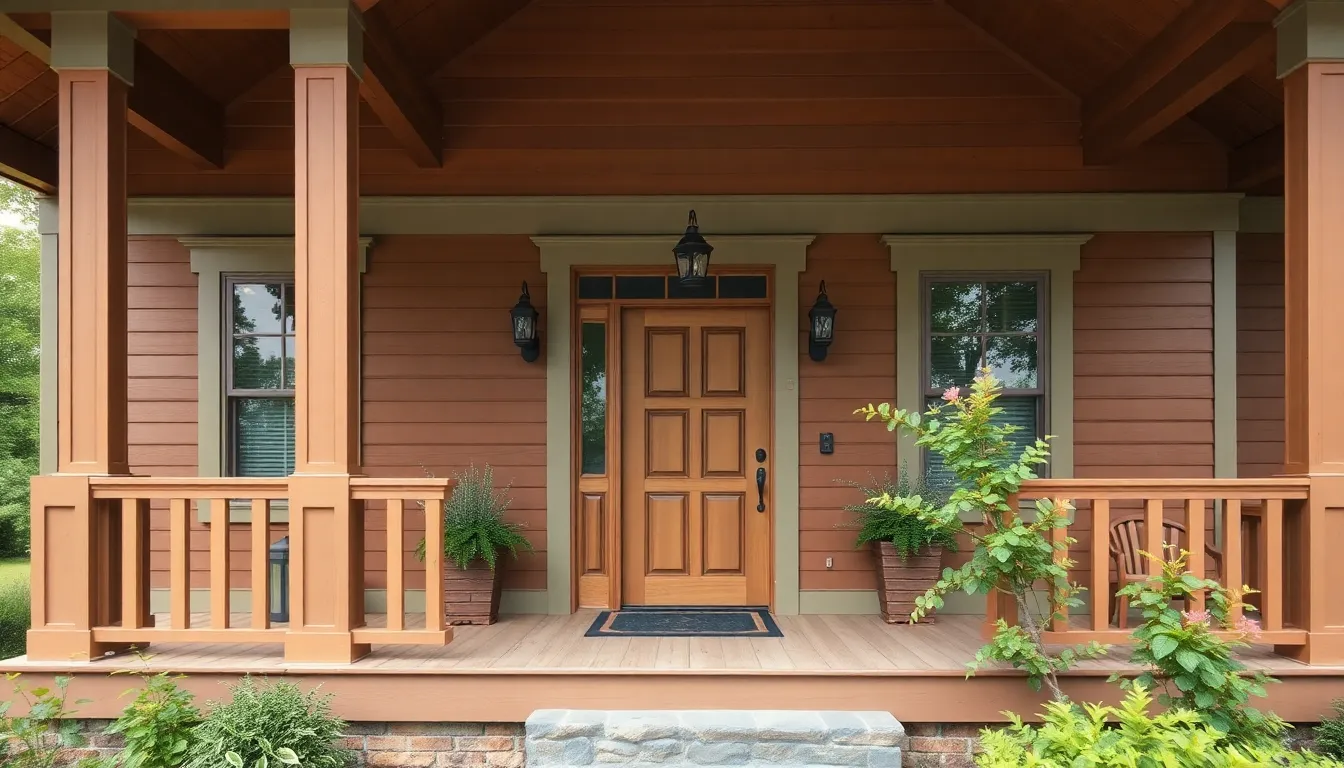
Selecting the right color palette brings together all those carefully chosen architectural elements we’ve discussed. The perfect color scheme enhances your porch’s natural materials while honoring traditional Craftsman design principles.
Earth-Tone Paint Palettes
Earth tones form the foundation of authentic Craftsman color schemes, creating harmony with the natural materials that define this architectural style. Warm browns anchor the palette while muted greens reflect the Arts and Crafts movement’s connection to nature. Deep reds add richness without overwhelming the design, and soft tans provide subtle contrast that complements wood, stone, and brick elements.
We recommend pairing these colors thoughtfully across different porch elements. Brown tones work beautifully on siding and larger surfaces, while muted greens enhance window trim and decorative details. Soft tans serve as excellent accent colors for railings and smaller architectural features, creating visual interest without disrupting the overall harmony.
Traditional Craftsman homes embrace these earth tone combinations because they age gracefully and maintain their appeal across seasons. The colors naturally complement the exposed beam ceilings and natural materials we’ve incorporated into your porch design.
Two-Tone Exterior Combinations
Two tone painting techniques highlight the handcrafted details that make Craftsman porches distinctive. Medium brown body colors paired with cream trim bring out the woodwork we’ve emphasized throughout your porch design. Olive trim against warm brown creates depth while maintaining the earthy palette essential to Craftsman style.
We suggest using the darker color on main surfaces like siding and porch walls, then applying the lighter contrasting shade to columns, railings, and window frames. This approach draws attention to those tapered columns and geometric railing patterns that define your porch’s character.
Contrasting colors should maintain enough difference to create definition without creating harsh transitions. The goal remains highlighting architectural craftsmanship rather than creating bold statements that detract from the overall design harmony.
Natural Wood Stain Options
Natural wood stains preserve the organic beauty of those cedar and redwood materials we’ve selected for your porch construction. Clear stains showcase the wood grain while providing protection against weather elements. Lightly tinted options enhance the natural color variations without masking the material’s inherent character.
We prefer stain over paint for major structural elements like exposed rafters, beams, and columns because it maintains the handcrafted appearance central to Craftsman philosophy. The wood’s texture remains visible and tactile, reinforcing the connection between your porch and natural materials.
Stain applications require proper preparation and technique to achieve consistent results across different wood surfaces. Multiple thin coats provide better protection and appearance than single thick applications, ensuring your porch maintains its authentic look for years to come.
Functional Storage and Organization Features
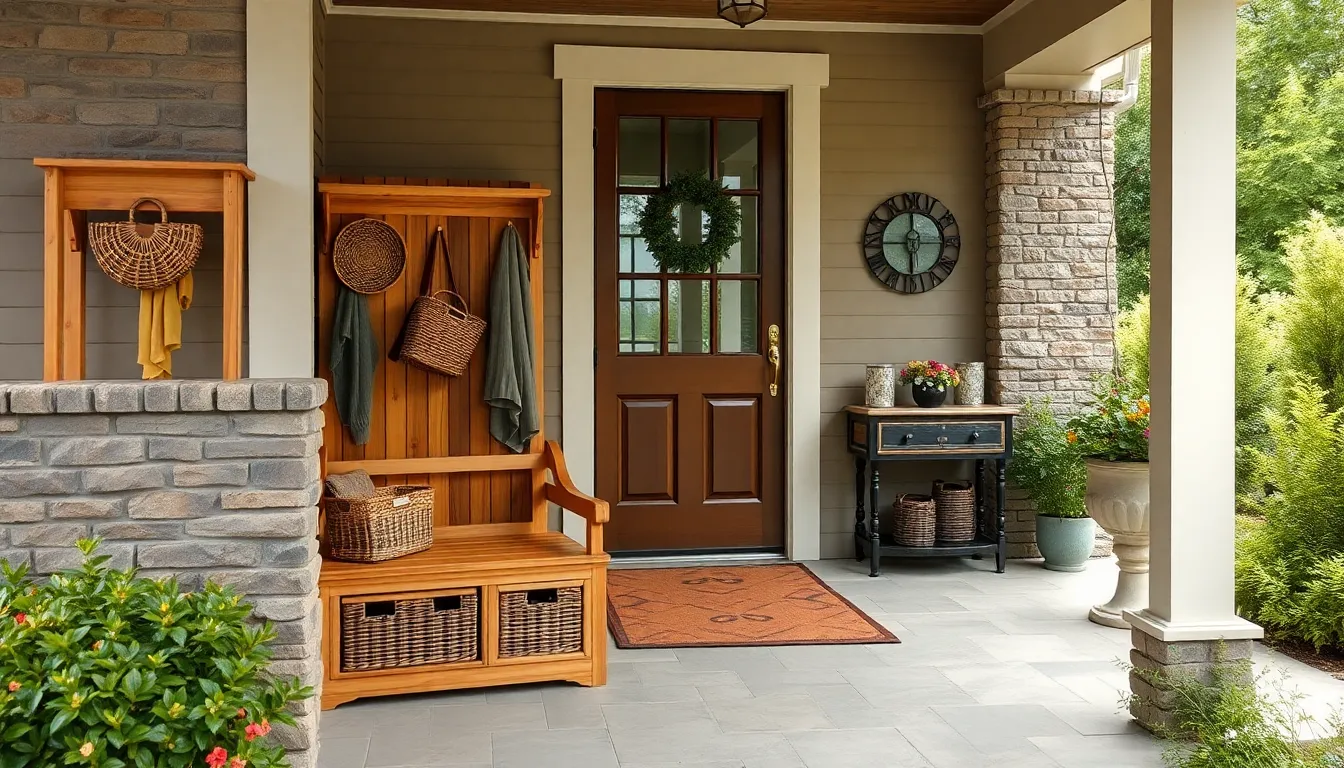
Building on the stunning architectural elements we’ve explored, our Craftsman porch design becomes even more practical with thoughtful storage answers. These functional features maintain the style’s signature natural materials while providing the organization modern families need.
Hidden Storage Benches
Hidden storage benches transform seating into dual purpose furniture that defines efficient Craftsman porch design. We recommend incorporating built-in benches with concealed storage underneath to serve both comfortable seating and discreet organization needs. These benches provide perfect answers for storing outdoor cushions, gardening tools, and seasonal decor while maintaining clean sightlines.
Natural wood construction using cedar or redwood ensures these storage benches blend seamlessly with existing porch columns and railings. Stone accents on bench bases create visual continuity with tapered stone columns we discussed earlier. Storage compartments benefit from weatherproof hinges and proper ventilation to protect stored items from moisture damage.
Sizing these benches appropriately means considering both seating comfort and storage capacity. We suggest depths of 18-20 inches for comfortable seating while providing ample storage space below. Length should complement the porch proportions, typically spanning 4-6 feet for optimal visual balance.
Built-In Coat and Shoe Storage
Built-in coat and shoe storage extends our living spaces onto the porch while maintaining organizational efficiency. These integrated answers provide functional places for coats, shoes, and umbrellas without cluttering the welcoming entrance we’ve carefully designed. Craftsman porches serve as transition zones between outdoor and indoor spaces, making these storage features essential.
Cubbies and shelves positioned near entry points offer convenient access while keeping items organized and protected. Wood materials matching porch columns and railings create cohesive design flow throughout the space. We recommend installing these storage elements at appropriate heights for family members, typically 5-6 feet for coat hooks and 12-18 inches for shoe storage.
Weather protection becomes crucial for these storage areas since they’re exposed to outdoor elements. Slanted tops on cubby systems prevent water accumulation, while proper spacing allows air circulation around stored items. Cedar construction provides natural resistance to moisture and insects.
Decorative Basket Organization
Decorative basket organization adds rustic charm while providing flexible storage answers throughout our Craftsman porch. Woven baskets crafted from natural wood or fibers complement the authentic aesthetic we’ve established with other design elements. These portable storage options offer versatility that built-in answers can’t match.
Strategic placement under storage benches or on integrated shelving systems maximizes space efficiency while maintaining visual appeal. We suggest selecting baskets in varying sizes to accommodate different storage needs, from small gardening tools to outdoor entertainment supplies. Natural tones and textures ensure these functional pieces enhance rather than detract from the overall design.
Basket materials should withstand outdoor conditions while maintaining their appearance over time. Treated wicker, bamboo, and sealed wood varieties provide durability against weather exposure. Regular maintenance includes cleaning and seasonal storage during harsh weather months to preserve their rustic beauty and functional integrity.
Seasonal Decoration and Landscaping Ideas
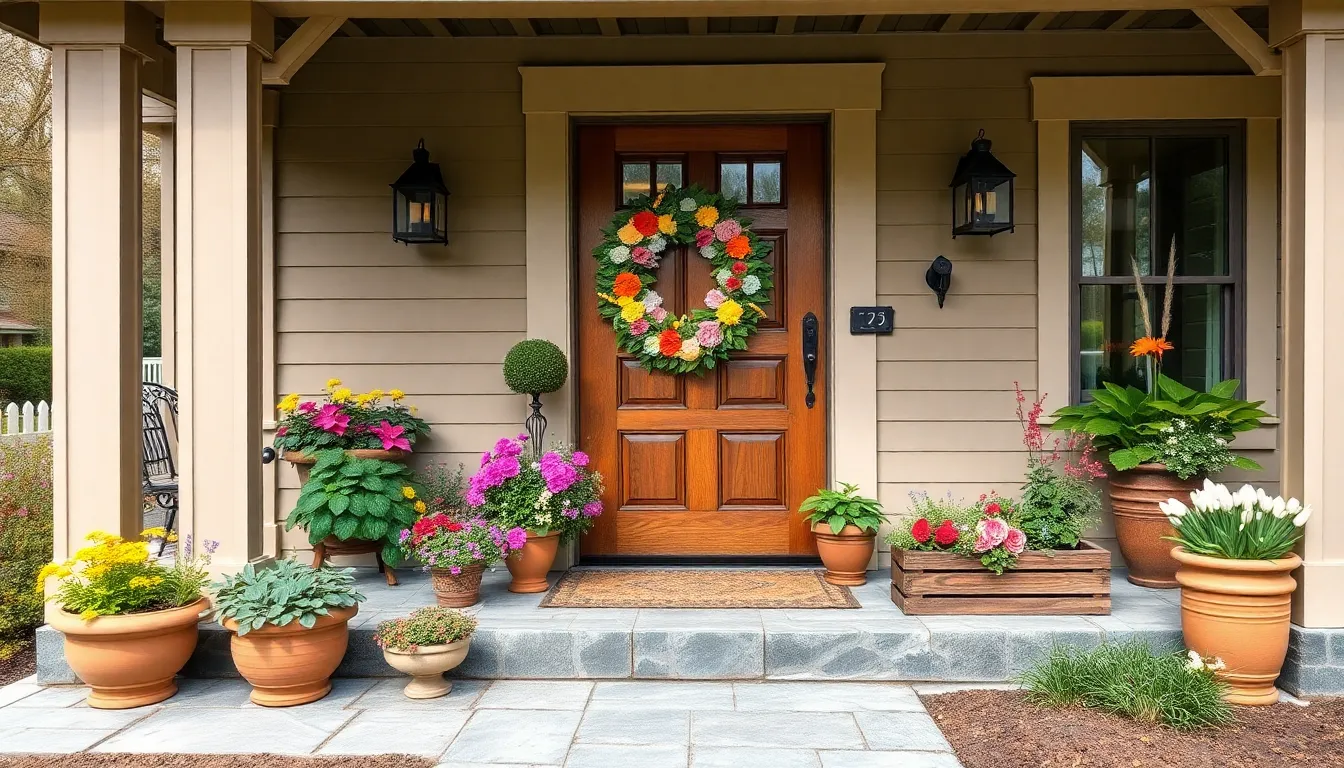
Transform your Craftsman porch into a year-round masterpiece by integrating natural seasonal elements that complement the architectural style. These landscaping approaches honor the Arts and Crafts movement’s emphasis on harmony with nature while providing ever-changing visual interest throughout the seasons.
Native Plant Arrangements
Native plants create the perfect foundation for authentic Craftsman porch landscaping since they naturally support the style’s commitment to environmental harmony. We recommend incorporating native shrubs like dogwoods and ornamental grasses around porch beds to establish low-maintenance borders that thrive in local conditions. Plant native flowering perennials such as coneflowers near the porch foundation to add seasonal color without overwhelming the natural aesthetic. Ferns work beautifully in shadier areas beneath overhangs, providing texture and year-round greenery that complements stone and wood elements. These native species require minimal maintenance while supporting local ecology, making them ideal choices for sustainable Craftsman landscaping that connects your porch seamlessly with the surrounding environment.
Seasonal Wreath Displays
Craftsman porches benefit from seasonal wreaths that echo the handcrafted warmth of Arts and Crafts design principles. Create spring wreaths using bright florals and fresh greenery to welcome the growing season with natural beauty. Summer displays can feature dried branches and seasonal berries arranged in loose, organic patterns that reflect the movement’s artisan aesthetic. Fall wreaths incorporating leafy elements and small pumpkins provide rich autumn colors that complement earth-tone porch palettes. Winter arrangements using evergreen boughs and pinecones maintain visual interest during colder months while honoring natural materials. These seasonal transitions keep your porch entrance inviting and fresh throughout the year, with each wreath change marking the natural rhythm of the seasons in true Craftsman fashion.
Container Garden Setups
Container gardens offer exceptional flexibility for Craftsman porches while bringing vibrant color and texture close to your entryway. Use terracotta or wooden planters that align with natural material preferences, avoiding synthetic containers that clash with authentic design elements. Layer plants with varying heights and textures to create naturalistic arrangements that complement stone and wood architectural details. Native flowers, succulents, and small shrubs work particularly well in container settings, providing seasonal interest without requiring permanent industry changes. Position larger containers near columns or seating areas to anchor the space, while smaller arrangements can accent steps or corners. These portable gardens allow you to experiment with different plant combinations throughout the seasons, maintaining the Craftsman principle of connecting indoor and outdoor living spaces through thoughtful natural elements.
Budget-Friendly DIY Craftsman Upgrades
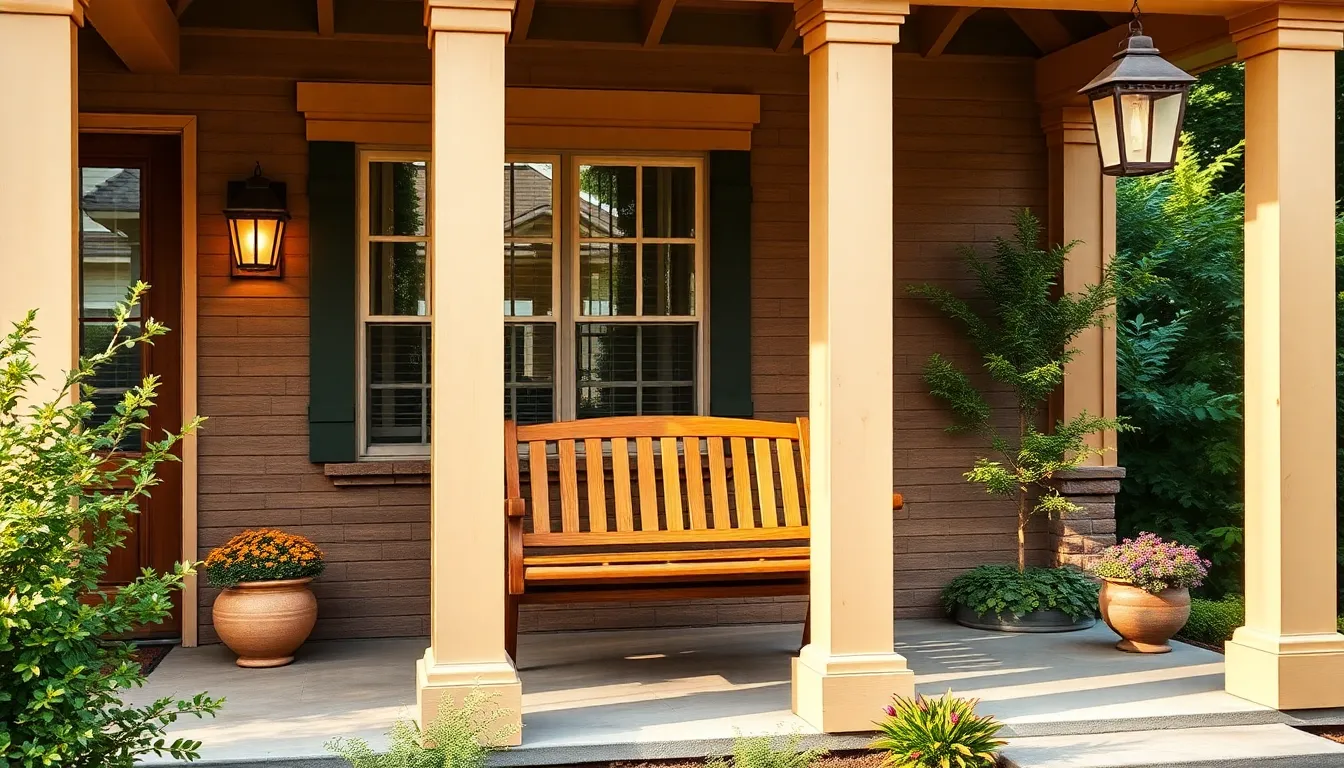
Building on our foundation of authentic materials and architectural details, we can transform any porch into a Craftsman masterpiece without very costly. Smart DIY upgrades focus on maximizing impact while minimizing expense.
Porch Swing Installation Projects
Installing a porch swing creates the perfect focal point for relaxation while honoring traditional Craftsman functionality. Position your swing near side columns or along one edge of the porch to maximize traffic flow and create an intimate seating area. Choose swings made from natural wood or painted finishes that complement your home’s exterior color scheme.
Hanging hardware requires careful attention to ceiling beam placement and weight distribution. Use heavy duty chains or rope rated for outdoor use, securing them to sturdy porch ceiling beams or rafters. Most Craftsman porches provide ample structural support for standard two person swings.
Natural wood swings blend seamlessly with existing porch elements like columns and railings. Cedar and redwood options resist weather damage while maintaining the handcrafted aesthetic we’ve established. Paint your swing in earth tones or stain it to match your porch’s existing woodwork for visual continuity.
Simple Column Wrapping Techniques
Wrapping existing posts transforms plain supports into architectural features that highlight traditional Craftsman proportions. Cut wood or composite materials to size and secure them around basic posts using construction adhesive and finishing nails. This approach costs significantly less than replacing entire columns.
Tapered designs create authentic Craftsman character by mimicking the proportions of original Arts and Crafts architecture. Start with wider measurements at the base and gradually narrow toward the top, maintaining consistent taper angles on all four sides. Stone or brick pier bases emphasize the classic Craftsman foundation detail.
Painted finishes or natural stains enhance the handcrafted appearance without requiring expensive materials. Choose colors that coordinate with your established earth tone palette, using contrasting shades to highlight architectural details. Composite wrapping materials offer durability with minimal maintenance compared to natural wood options.
Affordable Lighting Makeovers
Swapping standard fixtures for Craftsman style lanterns instantly updates your porch’s character and functionality. Look for metal and glass designs in warm bronze or black finishes that complement your color scheme. LED options reduce utility costs while providing the warm glow essential to Craftsman ambiance.
Strategic positioning near columns and steps creates both safety and visual appeal throughout your porch space. Install sconces at standard heights between 66 and 72 inches from the floor, ensuring they illuminate seating areas and walkways effectively. Mission style wall fixtures layer beautifully with overhead pendant lighting.
String lights and uplighting add charm on minimal budgets while creating inviting evening atmospheres. Wrap Edison bulb strings around porch beams or railings for vintage warmth that echoes traditional craftsmanship. Solar powered options eliminate electrical work while maintaining consistent lighting throughout the seasons.
Conclusion
Creating your dream Craftsman front porch doesn’t have to be overwhelming when you focus on authentic elements that honor this beloved architectural style. We’ve explored how the right combination of natural materials, thoughtful design details, and functional features can transform any entrance into a welcoming retreat.
The beauty of Craftsman design lies in its emphasis on quality craftsmanship and timeless appeal. Whether you’re working with a generous budget or seeking DIY answers, the key is maintaining consistency in your material choices and respecting the traditional proportions that make these porches so enduring.
Your front porch should reflect both your personal style and the architectural integrity of your home. By incorporating these design principles, you’ll create an outdoor space that not only enhances your property’s curb appeal but also provides a comfortable gathering place for years to come.
Frequently Asked Questions
What are the key architectural features that define a Craftsman porch?
Craftsman porches are characterized by tapered columns, exposed beam ceilings, built-in seating, and natural materials like stone and wood. These elements work together to create a welcoming space that emphasizes functionality and handcrafted details. The design typically features clean lines, geometric patterns, and earth-tone color schemes that complement the home’s architectural style.
What types of columns work best for authentic Craftsman porch design?
Three timeless approaches include tapered stone columns for dramatic natural texture, square wooden posts for clean lines and durability, and mixed material combinations using stone bases with wooden upper sections. Each option honors traditional Craftsman proportions while providing structural support and visual appeal that enhances the overall porch aesthetic.
How should I design railings for my Craftsman porch?
Choose between simple horizontal slat designs for a modern interpretation, geometric pattern railings featuring rectangular cutouts or diamond shapes, or built-in planter box railings that incorporate greenery. Use natural stained wood for authenticity and ensure proper spacing for safety while maintaining the handcrafted artistry characteristic of Craftsman design.
What lighting options best complement Craftsman porch design?
Traditional lantern-style pendant fixtures serve as centerpieces, while Mission-style wall sconces provide layered lighting. Warm Edison bulbs create vintage appeal in both fixtures. Install pendants at proper height for intimate lighting, position sconces to highlight architectural details, and consider dimmer switches for adjustable ambiance throughout different times of day.
Which natural materials should I incorporate into my Craftsman porch?
River rock foundations provide visual anchoring and durability for porch piers and skirting. Cedar and redwood offer decay resistance and beautiful grain patterns for accents and structural elements. Exposed beam ceilings with tongue-and-groove wood planks create signature architectural features that embody the Craftsman commitment to quality construction and natural materials.
How can I create comfortable seating arrangements on my Craftsman porch?
Built-in wooden benches made from natural wood provide sturdy seating with storage capabilities. Mission-style furniture should be arranged to foster social interaction while maintaining visual balance. Create cozy reading nooks with upholstered chairs or rockers positioned for natural light, and add soft furnishings in muted earth tones for comfort.
What color schemes work best for Craftsman porches?
Earth-tone palettes featuring warm browns, muted greens, deep reds, and soft tans create harmony with natural materials. Two-tone exterior combinations help highlight handcrafted details using contrasting colors effectively. Natural wood stains preserve the beauty of cedar and redwood while maintaining an authentic look that complements the architectural style.
How can I add functional storage to my Craftsman porch?
Hidden storage benches serve dual purposes of seating and organization while blending with existing elements. Built-in coat and shoe storage extends living spaces while maintaining a clutter-free entrance. Decorative basket organization provides flexible storage solutions that add rustic charm using durable materials suitable for outdoor conditions.
What are some budget-friendly DIY upgrades for Craftsman porches?
Install porch swings using proper hardware and natural wood materials as relaxation focal points. Use simple column wrapping techniques with tapered designs and painted finishes to transform plain posts. Create affordable lighting makeovers with Craftsman-style lanterns and string lights to establish inviting atmospheres without significant expense.
How should I landscape and decorate my Craftsman porch seasonally?
Integrate native plants like dogwoods and coneflowers for low-maintenance arrangements that thrive locally. Display seasonal wreaths that echo handcrafted warmth, and use container gardens for flexibility and vibrant color near the entryway. Choose decorations that complement the natural materials and earth-tone color scheme year-round.

